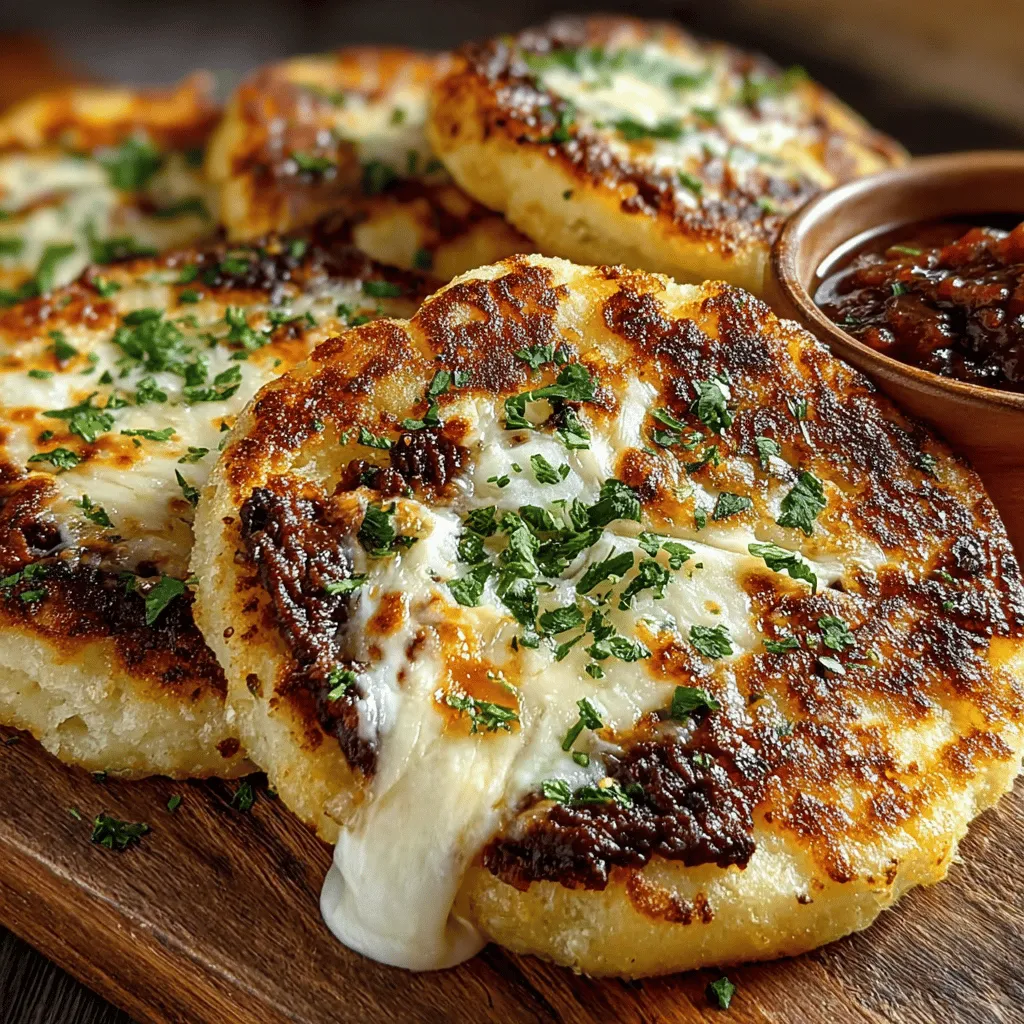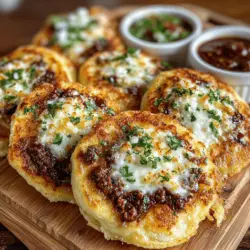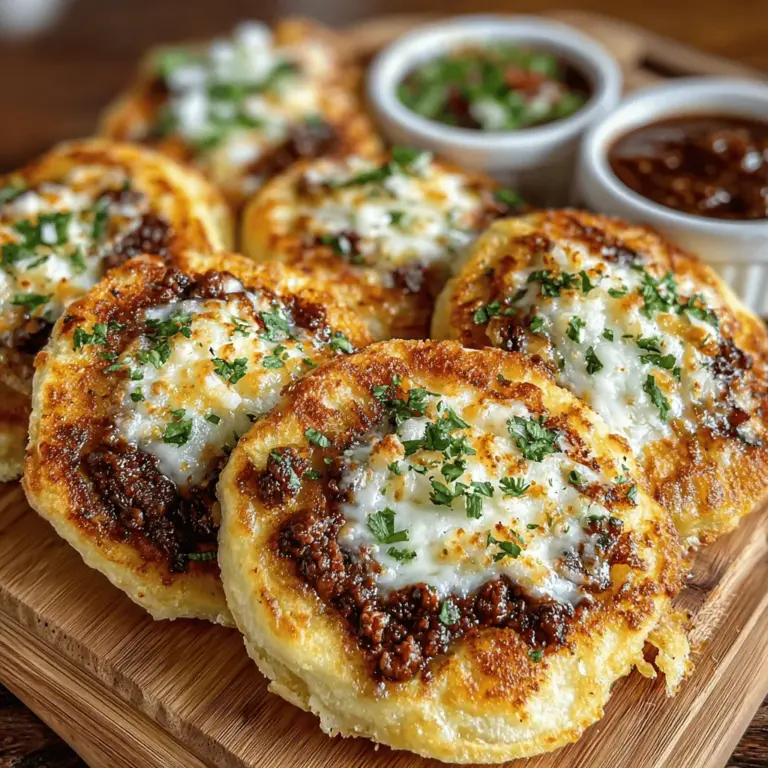Pupusas Fiesta Tortillas Recipe
Pupusas are a beloved traditional dish hailing from El Salvador, known for their deliciously stuffed corn tortillas that can be filled with a variety of ingredients. This delightful dish has gained popularity not just in Latin American cuisine but around the globe, making it a must-try for anyone looking to explore authentic flavors. The beauty of pupusas lies in their versatility; they can be filled with cheese, beans, meats, or vegetables, and topped with a tangy cabbage slaw known as curtido and salsa roja.
In El Salvador, pupusas are more than just a meal; they represent a cultural staple, often enjoyed during celebrations, family gatherings, and everyday meals alike. The process of making pupusas is a communal activity, bringing friends and family together to share in the joy of food preparation. The following recipe for Pupusas Fiesta Tortillas presents a fun and straightforward way for you to experience this culinary tradition in the comfort of your own home.
Understanding Pupusas
Pupusas can be defined as thick corn tortillas, typically made from masa harina, which is a special type of corn flour that is nixtamalized, giving the tortillas their unique texture and flavor. The origins of pupusas trace back to the indigenous Pipil people of El Salvador, where they have been a staple for centuries. Over time, regional variations have emerged, with different combinations of fillings and toppings, reflecting the diverse culinary landscape of Central America.
In addition to their delicious taste, pupusas hold a special place in Salvadoran culture. They are often served during festive occasions, such as the Day of the Pupusa, celebrated every second Sunday in November, where families and communities come together to enjoy this dish. The simplicity of pupusas makes them a favorite for everyday meals as well, often accompanied by a side of curtido, a fermented cabbage slaw, which adds a refreshing crunch and balances the richness of the fillings.
Ingredients Breakdown
To create your own Pupusas Fiesta Tortillas, you will need a selection of key ingredients that come together to form the perfect dough and flavorful fillings. Here’s a breakdown of what you’ll need:
1. Masa Harina: This is the cornerstone of pupusa dough. Masa harina is made from corn that has been treated with lime, resulting in a fine flour that is essential for creating the right texture. It provides a slightly nutty flavor and is gluten-free, making pupusas accessible to those with dietary restrictions.
2. Warm Water: Hydration is crucial in the dough-making process. Warm water helps to activate the masa harina, allowing the dough to become pliable and easy to shape. The temperature of the water can also affect the texture of the dough, so it’s important to use warm water rather than cold.
3. Salt: A small amount of salt enhances the flavor of the dough and is essential for balancing the ingredients. It also helps to strengthen the dough, making it easier to work with and shaping it into the perfect tortilla.
4. Shredded Mozzarella Cheese: Traditional pupusas often include cheese as a filling. While mozzarella is commonly used, you can experiment with other types of cheese, such as queso blanco or a sharp cheddar, to achieve different flavor profiles.
5. Refried Black Beans: Beans add a hearty element to pupusas, providing both flavor and nutrition. Refried black beans are a popular choice, but feel free to use pinto beans or even lentils for a different twist.
6. Fresh Cilantro: This herb adds a burst of freshness to the fillings. Its bright flavor complements the richness of the cheese and beans, enhancing the overall taste of the pupusas.
7. Ground Cumin and Garlic Powder: These spices elevate the flavor profile of your pupusas, adding depth and warmth. Cumin in particular is often associated with Latin American cuisine, providing an earthy aroma that pairs beautifully with the other ingredients.
8. Cooking Oil: A light coating of oil is essential for cooking the pupusas. You can choose from various types of cooking oil, such as vegetable, canola, or olive oil, each contributing a slightly different flavor and cooking characteristics.
Step-by-Step Instructions
Now that you have a clear understanding of the ingredients, let’s dive into the step-by-step instructions to create your very own Pupusas Fiesta Tortillas.
1. Prepare the Dough: In a large mixing bowl, combine 2 cups of masa harina with a teaspoon of salt. Gradually add warm water, mixing with your hands until a soft, pliable dough forms. The consistency should be similar to that of playdough – not too sticky and not too dry. If the dough feels too dry, add a bit more water, one tablespoon at a time.
2. Knead the Dough: Once the dough is formed, knead it gently for a few minutes to ensure it’s smooth and elastic. Cover the dough with a damp cloth to prevent it from drying out while you prepare the fillings.
3. Prepare the Fillings: In a separate bowl, mix your choice of fillings. For a classic combination, combine shredded mozzarella cheese, refried black beans, and finely chopped cilantro. Season the mixture with ground cumin and garlic powder to taste.
4. Form the Pupusas: Take a small ball of dough (about the size of a golf ball) and flatten it into a disk using your hands or a tortilla press. Aim for a thickness of about 1/4 inch. Place a spoonful of the filling mixture in the center of the disk. Carefully fold the edges over the filling to enclose it completely, pinching the dough to seal. Gently flatten the filled ball into a thicker disk, being careful not to let the filling escape.
5. Cook the Pupusas: Heat a skillet or griddle over medium heat and lightly grease it with cooking oil. Place the pupusas on the hot surface and cook for about 3-5 minutes on each side, or until they are golden brown and slightly crispy. The cheese should be melted and the dough cooked through.
With these initial steps, you are well on your way to creating delicious Pupusas Fiesta Tortillas that will impress your family and friends. Stay tuned for the next section, where we will explore additional toppings and serving suggestions to elevate your pupusa experience even further!

Preparing the Dough: Techniques for Achieving the Perfect Consistency
Creating the perfect pupusa starts with the dough, which is made from masa harina (corn flour). To achieve the right consistency, you should follow these steps:
1. Choosing the Right Masa Harina: Opt for a high-quality masa harina, specifically labeled for pupusas or tortillas. This ensures the dough has the right texture and flavor.
2. Mixing the Dough: In a large bowl, combine 2 cups of masa harina with 1 teaspoon of salt. Gradually add about 1 to 1.5 cups of warm water. Start with 1 cup and add more as needed. Use your hands to knead the mixture until it forms a smooth, pliable dough that doesn’t stick to your fingers. If the dough is too dry, add a bit more water; if it’s too wet, sprinkle in some additional masa harina.
3. Resting the Dough: Once mixed, cover the dough with a damp cloth and let it rest for at least 30 minutes. This resting period allows the masa to hydrate fully, making it easier to shape and ensuring the pupusas hold together well.
4. Testing the Consistency: After resting, take a small piece of dough and roll it into a ball. If it holds its shape and doesn’t crack at the edges, you have achieved the perfect consistency. If it cracks, knead in a little more water or masa harina and let it rest again.
Mixing the Filling: Tips for Balancing Flavors and Textures
The filling is the heart of pupusas and can significantly alter the flavor profile. Here’s how to create a delicious filling:
1. Traditional Filling Options: The most common fillings are cheese and refried beans. For a classic blend, use a combination of shredded mozzarella or quesillo (a soft, stretchy cheese) and cooked black beans or pintos.
2. Flavor Enhancements: Add chopped fresh cilantro, minced garlic, or diced jalapeños to the beans for an extra kick. These ingredients will enhance the overall flavor and provide a delightful contrast to the cheese. If you prefer a milder flavor, opt for sweet bell peppers instead.
3. Balancing Textures: Aim for a filling that offers a contrast of textures. For instance, if you choose to include meat (like cooked, shredded pork or chicken), ensure it’s finely shredded to blend well with the creaminess of the cheese and the smoothness of the beans.
4. Seasoning: Don’t forget to season your filling! A pinch of cumin, paprika, or even a dash of lime juice can elevate the flavor profile. Taste the filling before assembling your pupusas to ensure it meets your preferences.
Forming the Pupusas: Detailed Guidance on Shaping and Encasing Filling
Shaping pupusas might seem daunting, but with practice, you can master this technique. Follow these steps to form perfect pupusas:
1. Divide the Dough: After resting, divide the dough into equal-sized balls, roughly the size of a golf ball. Keep the balls covered with a damp cloth to prevent them from drying out.
2. Flattening the Dough: Take one ball of dough and flatten it between your palms to form a disc about ½ inch thick.
3. Adding the Filling: Place a spoonful of your desired filling in the center of the disc. Be careful not to overfill, as this can make sealing difficult.
4. Encasing the Filling: Gently fold the edges of the dough over the filling, pinching them together to seal in the filling. Then, press the dough into a disc again, being careful to ensure the filling does not escape. Aim for a thickness of about ½ inch.
5. Shaping Technique: You can also use a tortilla press to achieve a uniform thickness. Place the filled dough ball in the center of the press, cover it with plastic wrap, and press down gently to flatten.
Cooking Methods: Frying Tips for Achieving the Ideal Golden-Brown Finish
Cooking pupusas requires a bit of technique to ensure they are crispy on the outside and soft on the inside. Here’s how to do it right:
1. Choosing the Cooking Fat: Traditionally, pupusas are cooked on a griddle (comal) with a little oil. Use a neutral oil with a high smoke point, like vegetable or canola oil.
2. Heating the Griddle: Preheat your griddle over medium heat. To test if it’s hot enough, sprinkle a few drops of water on the surface; if they sizzle, the griddle is ready.
3. Frying the Pupusas: Add a thin layer of oil to the griddle. Place the pupusas on the hot surface, ensuring they are spaced apart. Cook for about 3-4 minutes on each side, or until golden brown and slightly crispy. You may need to adjust the heat to ensure they cook evenly without burning.
4. Finishing Touches: Once cooked, place the pupusas on a paper towel-lined plate to absorb excess oil. This step helps maintain their crispiness.
Serving Suggestions: Traditional Accompaniments Like Curtido and Salsa
Pupusas are traditionally served with delicious accompaniments that enhance their flavor. Here are some classic serving suggestions:
1. Curtido: This is a fermented cabbage slaw, often compared to sauerkraut, made with shredded cabbage, carrots, onions, and a touch of vinegar. Its tangy flavor complements the richness of the pupusas beautifully. You can make curtido at home by mixing shredded cabbage with carrots and onions, adding vinegar, water, salt, and spices to taste, and allowing it to ferment for a few hours or overnight.
2. Salsa Roja: A fresh tomato salsa made from ripe tomatoes, onions, cilantro, and lime juice is another excellent accompaniment. The freshness of the salsa adds a vibrant contrast to the warm, cheesy pupusas.
3. Avocado Slices: For a creamy texture, serve avocado slices or guacamole alongside your pupusas. The richness of the avocado pairs wonderfully with the dish.
4. Hot Sauce: For those who enjoy a little heat, providing a selection of hot sauces will allow guests to customize their pupusas to their taste.
Nutritional Information
Breakdown of the Nutritional Content per Serving
Pupusas are a satisfying meal option. On average, one pupusa filled with cheese and beans contains approximately:
– Calories: 150-200
– Protein: 6-8 grams
– Carbohydrates: 27 grams
– Dietary Fiber: 3-4 grams
– Fat: 4-5 grams
Health Benefits of Key Ingredients
1. Dietary Fiber: The beans used in pupusas are rich in dietary fiber, which is essential for digestive health and can help keep you feeling full longer.
2. Vitamins from Cilantro: If you include cilantro in your filling or salsa, you gain access to essential vitamins and antioxidants, enhancing the nutritional profile of your meal.
3. Balance of Indulgence and Health: While pupusas are indulgent and comforting, filling them with beans provides a good source of plant-based protein and fiber, making them a more balanced meal option.
Variations and Customizations
Pupusas are incredibly versatile, allowing for various fillings and adaptations. Here are some ideas to get you started:
Exploring Different Fillings
1. Meat: Consider fillings like seasoned ground beef, chorizo, or pulled pork. These can be mixed with cheese for added richness.
2. Vegetables: For a vegetarian option, try filling pupusas with sautéed mushrooms, spinach, or roasted peppers mixed with cheese.
3. Combination Fillings: Don’t hesitate to mix and match! A combination of beans, cheese, and vegetables can create a delightful medley of flavors.
Gluten-Free or Vegan Adaptations
1. Gluten-Free: Since pupusas are made from masa harina, they are inherently gluten-free. Just ensure that the fillings you choose do not contain gluten.
2. Vegan Options: Use plant-based cheese or skip the cheese entirely and focus on a filling of spiced lentils or sautéed vegetables for a hearty vegan pupusa.
Creative Toppings
1. Sour Cream or Diced Avocado: These toppings add a creamy texture that balances the savory flavors of the pupusa.
2. Pickled Jalapeños: For those who enjoy heat, pickled jalapeños can enhance the flavor profile of your pupusas.
Cultural Context and Serving Traditions
Pupusas hold a special place in Salvadoran culture, often enjoyed during family gatherings and festive occasions. Here are some insights into their cultural significance:
1. Family and Community: Making pupusas is a communal activity in many Salvadoran households. Families gather to prepare the dough and fillings together, fostering a sense of community and shared tradition.
2. Festive Occasions: During celebrations such as birthdays, holidays, and family reunions, pupusas are a staple dish. They are often served alongside other traditional foods, creating a feast that brings everyone together.
3. Personal Anecdotes: Many people recall fond memories of making pupusas with loved ones, passing down recipes from generation to generation. These experiences not only create delicious meals but also strengthen family bonds.
Conclusion
Pupusas are more than just a meal; they are a celebration of culture, family, and culinary tradition. Making pupusas at home allows you to explore their rich flavors while creating lasting memories with loved ones. Don’t hesitate to experiment with fillings and toppings to make this dish your own. The joy of crafting these delightful tortillas will not only satisfy your taste buds but also connect you to the vibrant culture of El Salvador. So gather your ingredients, invite your friends and family, and dive into the delicious world of pupusas!


